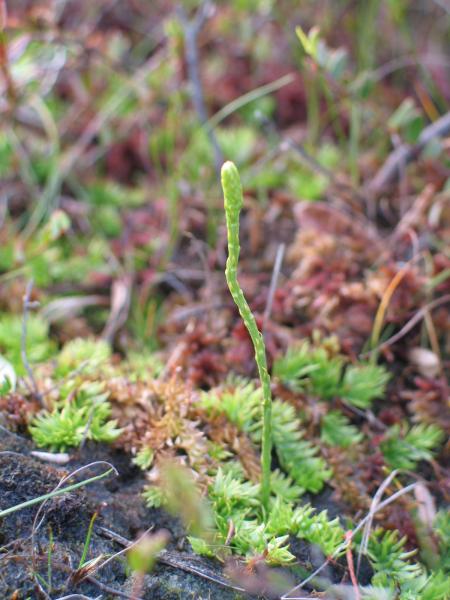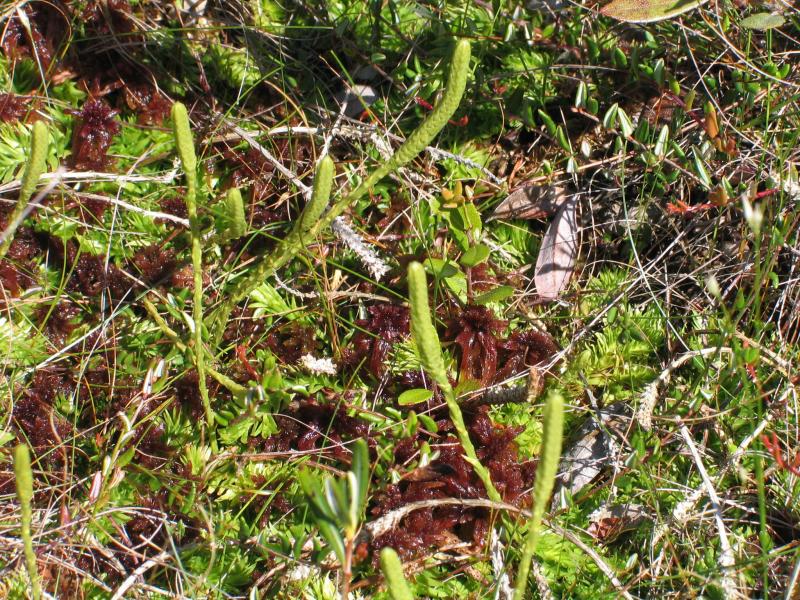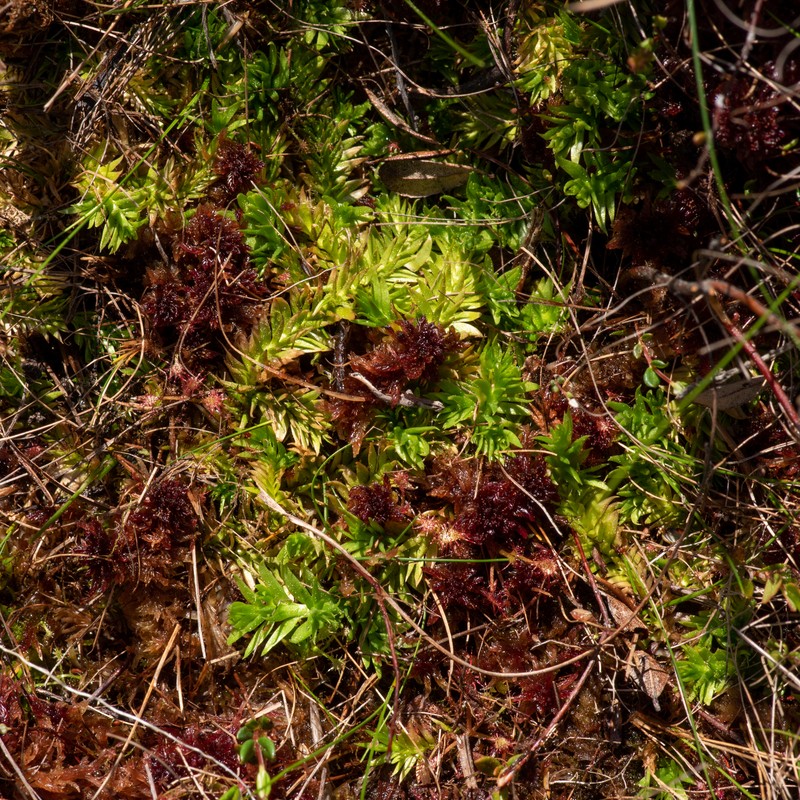Carolina Clubmoss
Pseudolycopodiella caroliniana (Linnaeus) Holub
- Class
- Lycopodiopsida (Clubmosses)
- Family
- Lycopodiaceae (Club-moss Family)
- State Protection
- Endangered
Listed as Endangered by New York State: in imminent danger of extirpation in New York. For animals, taking, importation, transportation, or possession is prohibited, except under license or permit. For plants, removal or damage without the consent of the landowner is prohibited.
- Federal Protection
- Not Listed
- State Conservation Status Rank
- S1
Critically Imperiled in New York - Especially vulnerable to disappearing from New York due to extreme rarity or other factors; typically 5 or fewer populations or locations in New York, very few individuals, very restricted range, very few remaining acres (or miles of stream), and/or very steep declines.
- Global Conservation Status Rank
- G5
Secure globally - Common in the world; widespread and abundant (but may be rare in some parts of its range).
Summary
Did you know?
Clubmosses are "primitive" plants, living relics of some of the earliest vascular plants. There are abundant fossils of tree-like lycopods or clubmosses, which are sometimes depicted in museum displays of dinosaurs. Such specimens are closely related to the smaller clubmosses still found today.
State Ranking Justification
There are only 3 existing occurrences (2 from Long Island and 1 from the Adirondacks) and 3 historical occurrences (all from Long Island).
Short-term Trends
More precise estimates of population size are needed in future surveys to determine the trends for this species.
Long-term Trends
This species has likely always been rare in New York. The few historical records were all collected from Long Island in the early 20th century; the Warren County population may represent a recent range expansion, or may simply have been overlooked until recently.
Conservation and Management
Threats
Damage by development or human use is a potential threat to the interdunal sites.
Conservation Strategies and Management Practices
The populations in interdunal swales should be protected from human activity. The population in the dwarf shrub bog should be protected from changes in the hydrology of the site. Cutting or other methods of maintaining open conditions may be appropriate management for Carolina Clubmoss if shrubs or trees begin to invade the areas occupied by the rare plants.
Habitat
Habitat
In New York Carolina Clubmoss has been found in two different types of open wetlands; on Long Island in interdunal swales, and in the Adirondacks in inundated portions of a large dwarf-shrub bog (New York Natural Heritage Program 2008).
Associated Ecological Communities
- Dwarf shrub bog
(guide)
A wetland usually fed by rainwater or mineral-poor groundwater and dominated by short, evergreen shrubs and peat mosses. The surface of the peatland is usually hummocky, with shrubs more common on the hummocks and peat moss throughout. The water in the bog is usually nutrient-poor and acidic.
- Maritime freshwater interdunal swales
(guide)
A mosaic of wetlands that occur in low areas between dunes along the Atlantic coast; the low areas (swales) are formed either by blowouts in the dunes that lower the soil surface to groundwater level, or by the seaward extension of dune fields. Water levels fluctuate seasonally and annually. Sedges and herbs are usually the most abundant types of plants. These wetlands may be quite small (less than 0.25 acre).
Associated Species
- Andromeda polifolia
- Andropogon glomeratus
- Calopogon tuberosus
- Carex exilis (meager sedge)
- Carex trisperma var. billingsii
- Chamaedaphne calyculata (leatherleaf)
- Decodon verticillatus (water-willow)
- Drosera intermedia (spatulate-leaved sundew)
- Dulichium arundinaceum
- Euthamia caroliniana (slender flat-topped-goldenrod)
- Euthamia te
- Gaylussacia baccata (black huckleberry)
- Hudsonia sp.
- Kalmia angustifolia
- Kalmia polifolia (bog laurel)
- Larix laricina (tamarack)
- Lycopodiella alopecuroides (fox-tail bog-clubmoss)
- Lycopodiella appressa (appressed-leaved bog-clubmoss, swamp bog-clubmoss)
- Lycopodiella inundata (northern bog-clubmoss)
- Myrica sp.
- Nuphar variegata (common yellow pond-lily, common spatter-dock)
- Picea mariana (black spruce)
- Platanthera blephariglottis
- Polytrichum sp.
- Rhynchospora alba (white beak sedge)
- Sarracenia purpurea (purple pitcherplant)
- Schizachyrium sp.
- Sphagnum rubellum
- Utricularia cornuta (horned bladderwort)
- Vaccinium macrocarpon (cranberry)
- Vaccinium oxycoccos (small cranberry)
- Viola lanceolata (lance-leaved violet)
Range
New York State Distribution
In New York this species is only known from Long Island and from a single site adjacent to Lake George in Warren County.
Global Distribution
Pseudolycopodiella caroliniana is found in the southern and eastern U.S. coastal states, from Texas north and east to New York and Massachusetts.
Identification Comments
General Description
Carolina Clubmoss is a perennial, evergreen, spore-bearing herb, creeping over wet substrates. The prostate stems (which may also root) are flat in cross section with six-ranked leaves. There are two rows of larger (lateral) leaves 3.5 to 6 mm by 1.2 to 2 mm and spreading, and 4 rows of smaller (median) leaves are 3.5 to 6 mm long by 0.3 to 0.6 mm wide, and spreading, with pointed tips. The peduncles are erect stems, usually solitary (sometimes 2 to 3), with widely spaced, scale-like leaves only 2 to 3 mm wide. The spores are borne in a solitary strobilus (1.5 to 9 mm long) at the end of the peduncle.
Best Life Stage for Proper Identification
Plants with fruiting stalks are best for identification.
Similar Species
Pseudolycopodiella caroliniana is the only species of Pseudolycopodiella in North America. There are four other genera of clubmosses in the state (Pseudolycopodiella previously was included in the genus Lycopodium). Carolina clubmoss can be distinguished from Lycopodiella, Huperzia, and Selago species because they have peduncles with widely separated, reduced, scale-like leaves (Lycopodiella has peduncles crowded with ordinary leaves), and from Lycopodium and Diphasiastrum species by having two types of stem leaves of different size, and by having the combination of a creeping habit and wet habitats.
Best Time to See
The fruits appear in July and persist through late fall.
- Vegetative
- Fruiting
The time of year you would expect to find Carolina Clubmoss vegetative and fruiting in New York.
Carolina Clubmoss Images
Taxonomy
Carolina Clubmoss
Pseudolycopodiella caroliniana (Linnaeus) Holub
- Kingdom Plantae
- Phylum Lycophyta
- Class Lycopodiopsida
(Clubmosses)
- Order Lycopodiales
- Family Lycopodiaceae (Club-moss Family)
- Order Lycopodiales
- Class Lycopodiopsida
(Clubmosses)
- Phylum Lycophyta
Additional Common Names
- Carolina Ground-pine
Synonyms
- Lycopodium carolinianum L.
- Pseudolycopodiella caroliniana (Linnaeus) Holub
Additional Resources
References
Flora of North America Editorial Committee. 1993a. Flora of North America north of Mexico. Vol. 2. Pteridophytes and gymnosperms. Oxford Univ. Press, New York. xvi + 475 pp.
Gleason, Henry A. and A. Cronquist. 1991. Manual of Vascular Plants of Northeastern United States and Adjacent Canada. The New York Botanical Garden, Bronx, New York. 910 pp.
Holmgren, Noel. 1998. The Illustrated Companion to Gleason and Cronquist's Manual. Illustrations of the Vascular Plants of Northeastern United States and Adjacent Canada. The New York Botanical Garden, Bronx, New York.
New York Natural Heritage Program. 2010. Biotics database. New York Natural Heritage Program. New York State Department of Environmental Conservation. Albany, NY.
New York Natural Heritage Program. 2024. New York Natural Heritage Program Databases. Albany, NY.
Weldy, T. and D. Werier. 2010. New York flora atlas. [S.M. Landry, K.N. Campbell, and L.D. Mabe (original application development), Florida Center for Community Design and Research http://www.fccdr.usf.edu/. University of South Florida http://www.usf.edu/]. New York Flora Association http://newyork.plantatlas.usf.edu/, Albany, New York
Weldy, Troy W. and David Werier. 2005. New York Flora Atlas. [S.M. Landry, K.N. Campbell, and L.D. Mabe (original application development), Florida Center for Community Design and Research. University of South Florida]. New York Flora Association, Albany, NY. Available on the web at (http://newyork.plantatlas.usf.edu/).
Links
About This Guide
Information for this guide was last updated on: February 1, 2023
Please cite this page as:
New York Natural Heritage Program. 2024.
Online Conservation Guide for
Pseudolycopodiella caroliniana.
Available from: https://guides.nynhp.org/carolina-clubmoss/.
Accessed July 26, 2024.


